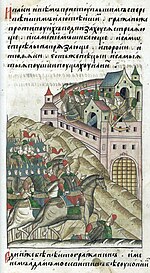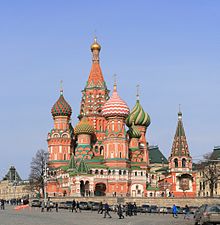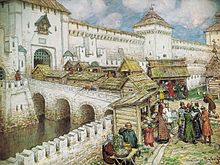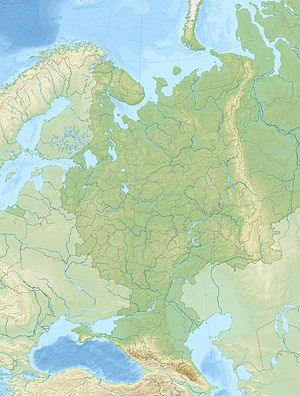Moscau
| Articul per Ladin Gherdëina |
| Moscau | |
|---|---|
| Москва | |
 | |
| La catedrela de San Basil y la Plaza Cuecena | |
 |
 |
| Bandiera | Blason |
| Nfurmazions prinzipeles | |
| Stat | |
| Raion federel | Zentrel |
| Soget federel | zità federela |
| Fundazion | 1147 do Gejù Crist |
| Populazion | 12 455 682 ab. (1 jené 2021) [1] |
| Densità | 4 861,7 ab./km² |
| Geografia | |
| Coordinedes | 55°45'21"N, 37°37'4"E |
| Autëza | 156 m sëura l livel dl mer |
| Spersa | 2 562 km² |
| Auter | |
| Zona d'orar | UTC+3 (MSK) |
| Codesc de la posta | 101001–135999 |
| Codesc OKTMO | 45000000 |
| Plata internet | www |
| Cherta | |
Moscau (rus: Москва, pronunzià [mɐˈskva] (![]() scota su)) ie la capitela y la majera zità de la Ruscia. La ie sul ruf Moskva tl Raion Federel Zentrel y à na populazion de 12,4 milions tl chemun, 17 milions tl raion urban y plu de 20 milions tl raion metropolitan. La zità se destira ora sun na spersa de 2.511 km². Moscau ie una de la majera ziteies al mond, la zità cun la majera populazion tl cuntinënt europeich y ënghe la zità cun la majera spersa te l'Europa.
scota su)) ie la capitela y la majera zità de la Ruscia. La ie sul ruf Moskva tl Raion Federel Zentrel y à na populazion de 12,4 milions tl chemun, 17 milions tl raion urban y plu de 20 milions tl raion metropolitan. La zità se destira ora sun na spersa de 2.511 km². Moscau ie una de la majera ziteies al mond, la zità cun la majera populazion tl cuntinënt europeich y ënghe la zità cun la majera spersa te l'Europa.
L prim iede ie Moscau stata documenteda tl 1147 y fova cresciuda a deventé na zità putënta y rica che fova deventeda la capitela dl Gran Ducat de Moscau. Canche l Gran Ducat fova deventà l Zarat de la Ruscia fova Moscau restà inant l zënter politich y economich de la Ruscia. Cun la formazion dl Mper Rus oven spustà la capitela da Moscau a San Petersburg y chësc ova smendrì l nflus de la zità. Do la revoluzion de Utober tl 1917 ova i Bolscevichs inò spustà la sënta dl guviern zeruch a Moscau.
Moscau ie la megazità plu a nord y plu frëida al mond, cun na storia de ot seculi, y ie guverneda coche na zità federela (dal 1993)[2] che ie l zënter pulitich, economich, culturel y scientifich de la Ruscia y de l'Europa dl est. Coche na zità globela alfa[3] à Moscau una de la majera economies urbanes al mond.[4] La zità ie una de la destinazions turistiches che crësc l plu debota al mond,[5] y ie una de la ziteies plu vijitedes de l'Europa. A Moscau vif l setim majer numer de miliarderes al mond.[6] L Zënter Nternaziunel de Cumerz de Moscau ie un di majeri zëntri finanzieres de l'Europa y à n grum di crazaciel plu auc de l'Europa. A Moscau fova stai i juesc olimpics dl 1980 y la fova una de la ziteies di campiunac dl mond dl 2018.[7]
Moscau ie l zënter storich de la Ruscia y ie la cësa de n gran numer de artisć, scienziac y sportifs per via dl gran numer de museums, istituzions academiches y pulitiches y teatri. Te la zità dal n gran numer de sic de l'Arpejon Mundiela UNESCO y la ie cunesciuda per i ejëmpli de architetura russa, dantaldut la plaza cuecena y frabicac sciche la catedrela de San Basil y l creml de Moscau, che ie nce la sënta dl guviern de la Ruscia. Moscau ie la sënta de n grum de firmes russes te n gran numer de industries y à na rë de trasport scialdi svilupeda, pra chëla che toca cater aeroporc nternaziunei, diesc stazions termineles de ferata, n sistem de trams, na monoscina y la metro de Moscau, che ie chëla cun l plu passajieres te l'Europa y una de la majera metros al mond. L 40% de la spersa de la zità ie vërda, cie che ne'n fej una de la ziteies plu vërdes te l'Europa y al mond.[8][9]
Storia[mudé | muda l codesc]
Gran Ducat (1283–1547)[mudé | muda l codesc]

|

|

|
| L Creml de Moscau ala fin dl 16ejim secul | La scascineda de Moscau dl 1382 | Plaza Cuecena |
Daniel ova renià Moscau coche gran duca nfin al 1303 y ne'n ova fat na zità de bënsté y richëza che fova deventeda plu putënta de si prinzipat dessëura, l prinzipat de Vladimir, ntëur al 1320. Moscau ova te chësc tëmp atirà n grum de muciadifs da autra pertes de la Ruscia. Tl 1304 se stritova Moscau y Tver per l cuntrol dl tron dl prinzipat de Vladimir. Ivan I ova ala fin abù la sëuravënta contra Tver y fova deventà l sëul a pudëi tlupé adum la chëutes per i renianc mongolesc. Nscì fova Moscau deventeda la capitela de Vladimir-Suzdal. Paian n tribut aut ova Ivan giatà cunzesions mpurtantes dal khan.

Scebën che n iede ulova la Horda d'Ora limité n influs de Moscau, canche l Gran Ducat de Lituania scumenciova a crëscer y mëter n pericul duta la Ruscia, ova l Khan scumencià a sustenì Moscau coche contrapëis a la Lituania, ti mpermetan nscì de deventé la zità plu putënta de la Ruscia. Tl 1380 ova l prinz Dmitry Donskoy de Moscau mandà na armeda liedia a bater i Mongolesc te la Batalia de Kulikovo. Daldò ova Moscau tëut su la pert de delibré la Ruscia dala dominazion di mongolesc. Tl 1480 ova Ivan III delibrà i rusc dal cuntrol di tataresc y Moscau fova deventeda la capitela de n mper che plu tert tulerà ite duta la Ruscia, la Siberia y mo autri raions.

Tl 1462 fova Ivan III (1440–1505) deventà l Gran Prinz de Moscau (che a chël tëmp fajova pert dl stat medievel de Moscau). Ël ova scumencià a cumbater i Tatars y slargià l raion de Moscau, purtan richëzes ala capitela. Tl 1500 ova Moscau arjont na populazion de 100 000 y fova a chël tëmp una de la majera ziteies al mond. Ël ov cuncuistà la scialdi majer prinzipat de Novgorod a nord, che se ova metù adum cun la Lituania. Ël ova ngrandì la spersa de dl ducat set iedesc, da 430 000 a 2 800 000 km².
L creml de Moscau fova unì frabicà tl 14ejim secul. L fova stat fat su da nuef da Ivan che ti ani 1480 ova nvià architec da la Talia dl Rinascimënt sciche Petrus Antonius Solarius, che ova dessenià l crem y si tores, y Marco Ruffo che ova dessenià l palaz dl prinz. I mures dl creml sciche i ie al didancuei fova sta cunpletei tl 1495.
N luech de cumerz o posad fova nasciù a est dl creml te n raion che se tlama Saradie (Зарядье). Tl tëmp de Ivan III ie unida a se l dé la plaza cuecena , che ova n iede inuem ciamp uet (Полое поле).
In 1508–1516, the Italian architect Aleviz Fryazin (Novy) arranged for the construction of a moat in front of the eastern wall, which would connect the Moskva and Neglinnaya and be filled in with water from Neglinnaya. This moat, known as the Alevizov moat and having a length of 541 metres (1,775 feet), width of 36 metres (118 feet), and a depth of 9.5 to 13 metres (31–43 feet) was lined with limestone and, in 1533, fenced on both sides with low, 4-metre-thick (13-foot)* cogged-brick walls.
Zarat (1547–1721)[mudé | muda l codesc]

In the 16th and 17th centuries, the three circular defenses were built: Kitay-gorod (Китай-город), the White City (Белый город) and the Earthen City (Земляной город). However, in 1547, two fires destroyed much of the town, and in 1571 the Crimean Tatars captured Moscow, burning everything except the Kremlin.[10] The annals record that only 30,000 of 200,000 inhabitants survived.

The Crimean Tatars attacked again in 1591, but this time were held back by new defense walls, built between 1584 and 1591 by a craftsman named Fyodor Kon. In 1592, an outer earth rampart with 50 towers was erected around the city, including an area on the right bank of the Moscow River. As an outermost line of defense, a chain of strongly fortified monasteries was established beyond the ramparts to the south and east, principally the Novodevichy Convent and Donskoy, Danilov, Simonov, Novospasskiy, and Andronikov monasteries, most of which now house museums. From its ramparts, the city became poetically known as Bielokamennaya, the "White-Walled." The city's limits as marked by the ramparts built in 1592 are now marked by the Garden Ring.
Three square gates existed on the eastern side of the Kremlin wall, which in the 17th century, were known as Konstantino-Eleninsky, Spassky, Nikolsky (owing their names to the icons of Constantine and Helen, the Saviour and St. Nicholas that hung over them). The last two were directly opposite the Red Square, while the Konstantino-Elenensky gate was located behind Saint Basil's Cathedral.

The Russian famine of 1601–03 killed perhaps 100,000 in Moscow. From 1610 through 1612, troops of the Polish–Lithuanian Commonwealth occupied Moscow, as its ruler Sigismund III tried to take the Russian throne. In 1612, the people of Nizhny Novgorod and other Russian cities conducted by prince Dmitry Pozharsky and Kuzma Minin rose against the Polish occupants, besieged the Kremlin, and expelled them. In 1613, the Zemsky sobor elected Michael Romanov tsar, establishing the Romanov dynasty. The 17th century was rich in popular risings, such as the liberation of Moscow from the Polish–Lithuanian invaders (1612), the Salt Riot (1648), the Copper Riot (1662), and the Moscow Uprising of 1682.
During the first half of the 17th century, the population of Moscow doubled from roughly 100,000 to 200,000. It expanded beyond its ramparts in the later 17th century. It is estimated, that in the middle of the 17th century, 20% of Moscow suburb's inhabitants were from the Grand Duchy of Lithuania, practically all of them being driven from their homeland to Moscow by Muscovite invaders.[11] By 1682, there were 692 households established north of the ramparts, by Ukrainians and Belarusians abducted from their hometowns in the course of the Russo-Polish War (1654–1667). These new outskirts of the city came to be known as the Meshchanskaya sloboda, after Ruthenian meshchane "town people". The term meshchane (мещане) acquired pejorative connotations in 18th-century Russia and today means "petty bourgeois" or "narrow-minded philistine".[12]
The entire city of the late 17th century, including the slobodas that grew up outside the city ramparts, are contained within what is today Moscow's Central Administrative Okrug.
Numerous disasters befell the city. The plague epidemics ravaged Moscow in 1570–1571, 1592 and 1654–1656.[13] The plague killed upwards of 80% of the people in 1654–55. Fires burned out much of the wooden city in 1626 and 1648.[14] In 1712 Peter the Great moved his government to the newly built Saint Petersburg on the Baltic coast. Moscow ceased to be Russia's capital, except for a brief period from 1728 to 1732 under the influence of the Supreme Privy Council.
Mper (1721–1917)[mudé | muda l codesc]

After losing the status as the capital of the empire, the population of Moscow at first decreased, from 200,000 in the 17th century to 130,000 in 1750. But after 1750, the population grew more than tenfold over the remaining duration of the Russian Empire, reaching 1.8 million by 1915. The 1770–1772 Russian plague killed up to 100,000 people in Moscow.[15]

By 1700, the building of cobbled roads had begun. In November 1730, the permanent street light was introduced, and by 1867 many streets had a gaslight. In 1883, near the Prechistinskiye Gates, arc lamps were installed. In 1741 Moscow was surrounded by a barricade 40 kilometres (25 mi) long, the Kamer-Kollezhskiy barrier, with 16 gates at which customs tolls were collected. Its line is traced today by a number of streets called val (“ramparts”). Between 1781 and 1804 the Mytischinskiy water pipe (the first in Russia) was built. In 1813, following the destruction of much of the city during the French occupation, a Commission for the Construction of the City of Moscow was established. It launched a great program of rebuilding, including a partial replanning of the city-centre. Among many buildings constructed or reconstructed at this time was the Grand Kremlin Palace and the Kremlin Armoury, the Moscow University, the Moscow Manege (Riding School), and the Bolshoi Theatre. In 1903 the Moskvoretskaya water supply was completed.
In the early 19th century, the Arch of Konstantino-Elenensky gate was paved with bricks, but the Spassky Gate was the main front gate of the Kremlin and used for royal entrances. From this gate, wooden and (following the 17th-century improvements) stone bridges stretched across the moat. Books were sold on this bridge and stone platforms were built nearby for guns – "raskats". The Tsar Cannon was located on the platform of the Lobnoye mesto.
The road connecting Moscow with St. Petersburg, now the M10 highway, was completed in 1746, its Moscow end following the old Tver road, which had existed since the 16th century. It became known as Peterburskoye Schosse after it was paved in the 1780s. Petrovsky Palace was built in 1776–1780 by Matvey Kazakov.

When Napoleon invaded Russia in 1812, the Moscovites were evacuated. It is suspected that the Moscow fire was principally the effect of Russian sabotage. Napoleon's Grande Armée was forced to retreat and was nearly annihilated by the devastating Russian winter and sporadic attacks by Russian military forces. As many as 400,000 of Napoleon's soldiers died during this time.[16]

Moscow State University was established in 1755. Its main building was reconstructed after the 1812 fire by Domenico Giliardi. The Moskovskiye Vedomosti newspaper appeared from 1756, originally in weekly intervals, and from 1859 as a daily newspaper.
The Arbat Street had been in existence since at least the 15th century, but it was developed into a prestigious area during the 18th century. It was destroyed in the fire of 1812 and was rebuilt completely in the early 19th century.
In the 1830s, general Alexander Bashilov planned the first regular grid of city streets north from Petrovsky Palace. Khodynka field south of the highway was used for military training. Smolensky Rail station (forerunner of present-day Belorussky Rail Terminal) was inaugurated in 1870. Sokolniki Park, in the 18th century the home of the tsar's falconers well outside Moscow, became contiguous with the expanding city in the later 19th century and was developed into a public municipal park in 1878. The suburban Savyolovsky Rail Terminal was built in 1902. In January 1905, the institution of the City Governor, or Mayor, was officially introduced in Moscow, and Alexander Adrianov became Moscow's first official mayor.
When Catherine II came to power in 1762, the city's filth and the smell of sewage were depicted by observers as a symptom of disorderly lifestyles of lower-class Russians recently arrived from the farms. Elites called for improving sanitation, which became part of Catherine's plans for increasing control over social life. National political and military successes from 1812 through 1855 calmed the critics and validated efforts to produce a more enlightened and stable society. There was less talk about the smell and the poor conditions of public health. However, in the wake of Russia's failures in the Crimean War in 1855–56, confidence in the ability of the state to maintain order in the slums eroded, and demands for improved public health put filth back on the agenda.[17]
Geografia[mudé | muda l codesc]
Tlima[mudé | muda l codesc]
|
Temperatures mesanes y prezipitazions per Moscau
Funtana: wetterkontor.de[18]
| ||||||||||||||||||||||||||||||||||||||||||||||||||||||||||||||||||||||||||||||||||||||||||||||||||||||||||||||||||||||||||||||||||||||||||||||||||||||||||||||||||||||||||||||||||||||||||||||||||||||||||||||||||||||||||||||||||||||||||||||||
Trasport[mudé | muda l codesc]
Metro[mudé | muda l codesc]

Liej de plu tl articul: Metro de Moscau
La metro de Moscau ie cunesciuda per si ert, mosaics, urnamënc y candelieresc. L fova stata giaurida tl 1935 y fova bel snel deventeda n pez zentrel tl sistem de trasport de la zità.
Cëla nce[mudé | muda l codesc]
Referënzes[mudé | muda l codesc]
- ↑ https://www.citypopulation.de/en/russia/cities/.
- ↑ "A glimpse into history". mos.ru. Archivià da l uriginel ai October 7, 2021. Trat ite ai September 21, 2021.
- ↑ According to the Globalization and World Cities Research Network
- ↑ Brade, Isolde; Rudolph, Robert (2004). "Moscow, the Global City? The Position of the Russian Capital within the European System of Metropolitan Areas". Area. Wiley. 36 (1): 69–80. doi:10.1111/j.0004-0894.2004.00306.x. JSTOR 20004359.
- ↑ aldò dl MasterCard Global Destination Cities Index
- ↑ McEvoy, Jemima. "Where The Richest Live: The Cities With The Most Billionaires 2022". Forbes (per inglese). Trat ite ai 2022-07-06.
- ↑ "FIFA World Cup kicks off in Russia". The New Indian Express. Archivià da l uriginel ai August 2, 2021. Trat ite ai March 20, 2021.
- ↑ Fal tles notes: Errore nell'uso del marcatore
<ref>: non è stato indicato alcun testo per il marcatorePlanète Énergies - ↑ "Moscow parks". Bridge To Moscow. Trat ite ai May 27, 2020.
- ↑ "The Unending Frontier: An Environmental History of the Early Modern World Archived nuvëmber 22, 2022, te la Wayback Machine". John F. Richards (2006). University of California Press. p. 260. ISBN 0-520-24678-0
- ↑ Абецедарский, Л. С. (1978). Белоруссия и Россия (per russo). Москва. p. 213.
- ↑ П.В.Сытин, "Из истории московских улиц", М, 1948, p. 296.
- ↑ Bubonic Plague in Early Modern Russia: Public Health and Urban Disaster Archived nuvëmber 22, 2022, te la Wayback Machine. John T. Alexander (2002). Oxford University Press US. p. 17. ISBN 0-19-515818-0
- ↑ M.S. Anderson, Peter the Great (1978) p. 13
- ↑ Melikishvili, Alexander (2006). "Genesis of the anti-plague system: the Tsarist period" (PDF). Critical Reviews in Microbiology. 36 (1): 19–31. CiteSeerX 10.1.1.204.1976. doi:10.1080/10408410500496763. PMID 16610335. S2CID 7420734. Archivià da l uriginel (PDF) ai November 23, 2009. Trat ite ai March 22, 2020.
- ↑ "The Russian Army of the Napoleonic Wars". Albert Seaton, Michael Youens (1979). p. 29. ISBN 0-88254-167-6
- ↑ Alexander M. Martin, "Sewage and the City: Filth, Smell, and Representations of Urban Life in Moscow, 1770–1880", Russian Review (2008) 67#2 pp. 243–274.
- ↑ wetterkontor.de

